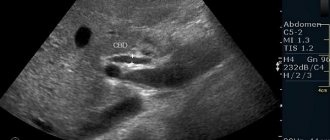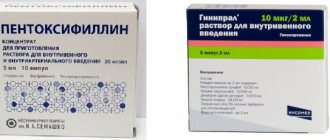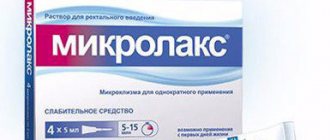Pharmacodynamics and pharmacokinetics
the lincosamide antibiotic clindamycin as an active ingredient , is a local remedy used in gynecology for the treatment of gardnerellosis (vaginosis) of bacterial origin. The mechanism of action of local dosage forms of the drug (cream, suppositories) is aimed at disrupting the processes of intracellular protein synthesis in the microbial cell, which occurs at the level of the large ribosomal subunit 50S.
The spectrum of action of clindamycin is quite wide. In medium doses, the drug exhibits bacteriostatic effectiveness against many microorganisms . At higher dosages, clindamycin is characterized by a bactericidal effect aimed at destroying certain bacterial strains .
The main activity of clindamycin is observed against microorganisms leading to the formation of bacterial vaginosis , including: Mobiluncus spp. (mobiluncus), Gardnerella vaginalis (Gardnerella vaginalis), Bacteroides spp. (bacteroides), Peptostreptococcus spp. (peptostreptococci), Mycoplasma hominis (mycoplasma hominis).
Strains of Candida albicans ( thrush ) and Trichomonas vaginalis ( Trichomonas vaginalis insensitive to the effects of clindamycin .
Intravaginal (inside the vagina) single administration of clindamycin at a dose of 100 mg leads to systemic absorption of approximately 4% of the drug (about 4 mg). Plasma Cmax of clindamycin is 20 ng/ml.
Dosage
Clindacin B prolong cream should be administered intravaginally through an applicator. It must be used once, preferably before going to bed. The dose recommended for use is one full applicator, that is, five grams of cream, one hundred milligrams per share of both active substances. The course of treatment is three days, use is daily.
Side effects
Some patients, when using Clindacin, experienced the development of negative side effects, including: a feeling of itching in the vagina , the formation of a maculopapular rash , the occurrence of urticaria , the development of cervicitis or colpitis (vaginitis), vulvovaginal irritation burning sensation .
In rare cases, the following were observed from the hematopoietic system: thrombocytopenia , reversible leukopenia , eosinophilia , neutropenia , agranulocytosis .
In case of significant systemic absorption of clindamycin, its inherent systemic side effects may occur, including the formation of pseudomembranous enterocolitis (very rare).
Side effects
During the entire period of use of the drug in gynecological practice, its normal tolerability in patients was noted. If any cases of side effects were recorded, they were isolated. However, when prescribing Clindacin, one should take into account the possibility of:
- allergic reactions in the form of rashes accompanied by itching, urticaria;
- along the urogenital tract it is possible to develop irritation in the genital area of an external nature, the development of colpitis or cercivitis;
- extremely rare phenomena of the development of agranulocytosis, neutropenia and other similar abnormalities in blood counts;
- among systemic deviations, the manifestation of symptoms of pseudomembranous enterocolitis is possible, as in cases of use of other antibiotics.
Overdose
Not a single case of overdose of the drug in any of its dosage forms has been recorded.
Drug interactions
Drug interactions with Clindamycin can only be considered as antagonism with erythromycin and cross-resistance with lincomycin.
Additional instructions
The patient should be warned that the drug should not be abused, since its systematic use can create a favorable environment for the reproduction and growth of candida, since this type of microorganism is not sensitive to the drug.
Dyspeptic disorders serve as a signal for stopping treatment. Also, you should not combine treatment with Clindacin with other drugs for similar purposes.
If necessary, the drug Clindacin in the form of a suppository can be purchased without a doctor’s prescription, but to purchase the cream of the same name, its presence will be required.
Instructions for use of Clindacin (Method and dosage)
Clindacin cream, instructions for use
Clindacin cream is intended for intravaginal use using a special disposable applicator included in the package with the medicinal product. The recommended single daily dosage of the cream is 100 mg of clindamycin (the volume of a completely filled applicator). It is best to administer the drug in the evening (before bedtime). The duration of the treatment course, as a rule, takes from 3 to 7 days.
Using the applicator
For proper dosing and introduction of the cream into the vagina, it is recommended to use disposable applicators contained in the package with the drug and adhere to the technique for their use, namely:
- remove the protective cap from the tube of cream;
- screw a disposable plastic applicator into its place;
- squeeze the opposite end of the tube to completely fill the applicator (the applicator is considered completely filled when its independently moving piston reaches the stop);
- lying on your back, insert the applicator into the vagina as deeply as possible;
- Gently press the applicator piston until it is completely empty;
- Carefully remove the used applicator from the vagina and throw it away.
Clindacin suppositories, instructions for use
Clindacin suppositories are also used intravaginally, with a single daily administration of 1 suppository, preferably in the evening (before bedtime). The duration of the treatment course, as a rule, takes from 3 to 7 days.
For proper use of the drug, one suppository should be released from the outer contour packaging by cutting the protective film along the contours of the suppository. Then, in a lying position, insert the suppository into the vagina as deeply as possible.
Indications and contraindications
The indications for Clindacin B Prolong cream are fungal, bacterial, and mixed vaginosis caused by microorganisms that are sensitive to this drug.
Contraindications are:
- ulcerative and pseudomembranous colitis (including medical history);
- Crohn's disease;
- age up to eighteen years;
- high sensitivity to any component of the drug.
It should be used with caution in the presence of allergic diseases, as well as when using muscle relaxants together.
Interaction
When used in combination with clindamycin, the effectiveness of aminoglycosides ( Streptomycin ), Rifampicin and Gentamicin .
Clindamycin is incompatible with Aminophylline , Erythromycin , Magnesium sulfate , Ampicillin , Calcium gluconate , diphenylhydantoin and barbiturates.
The effects of clindamycin increase muscle relaxation caused by the effects of n-cholinergic blockers .
Clindacin suppositories: instructions, use, reviews
Clindacin suppositories belong to the group of antibacterial drugs and have bactericidal properties. The chemical basis of the drug is an antibiotic called clindamycin, which destroys pathogenic microflora of the vagina.
Thus, under its direct influence, most microorganisms die, and other pathogenic bacteria become less active and lose their ability to multiply rapidly.
However, fungi of the genus Candida and the causative agents of trichomoniasis are not sensitive to this antibiotic, so it makes no sense to use it for characteristic diseases.
Clindacin is almost instantly absorbed from the gastrointestinal tract and penetrates imperceptibly into tissues, but at the same time it is difficult for it to overcome the placental barrier. The therapeutic effect lasts up to 12 hours, and after that clindamycin is metabolized in the liver, where some of the metabolites are excreted in the urine and some through the intestines. The spectrum of action in the body is similar to lincomycin.
In modern pharmacology, Clindacin vaginal suppositories, capsules and Clindacin cream are known.
Among the analogues of Clindacin are Dalatsin, Klimitsin, Clindamycin, Klindeks, Klindovit and Zerkalin.
Indications and contraindications for the use of Clindacin suppositories
Clindacin suppositories are often prescribed for bacterial vaginosis caused by microorganisms hypersensitive to clindamycin.
Contraindications to the use of Clindacin suppositories are kept to a minimum. Restrictions apply to patients in the first trimester of pregnancy and with increased sensitivity to the active ingredients of Clindacin suppositories.
Prescribe with caution during lactation, since a small part is still excreted in breast milk, as well as in case of pathologies of the liver and kidneys.
Side effects and overdose of Clindacin suppositories
Treatment with Clindacin suppositories may result in unexpected worsening of side effects. Thus, anomalies of the genitourinary system are represented by cervicitis and vaginitis, and anomalies of the hematopoietic organs are represented by reversible leukopenia, agranulocytosis and thrombocytopenia. Allergic reactions, expressed by urticaria and itching at the injection site, also occur.
No cases of overdose have been identified.
Instructions for use of Clindacin suppositories
The instructions for use indicate that the course of treatment with Clindacin varies from 3 to 7 days. During this time, one suppository should be inserted into the vagina once a day, preferably in a lying position. One way or another, Clindacin suppositories are an antibiotic and should be taken on the recommendation of a specialist, who will also determine the required dosage.
Features of the use of Clindacin suppositories
The drug is available without a prescription.
He is involved in the treatment of vaginitis in young children and adolescents. In this case, the required dosage is determined by a specialist in order to avoid extremely undesirable consequences.
During the treatment period, driving vehicles and engaging in work activities that require increased attention are allowed.
When prescribing Clindacin suppositories during pregnancy, the benefit to the mother and the harm to the baby should be weighed.
Clindacin vaginal suppositories should not be used simultaneously with other intravaginal medications.
In case of drug interactions, Clindacin is not recommended to be combined with ampicillin, erythromycin, calcium gluconate, barbiturates, diphenylhydantoin, aminophylline and magnesium sulfate.
In addition, this drug significantly enhances the effect of rifampicin, aminoglycosides - gentamicin, streptomycin, and its simultaneous use with antidiarrheal drugs can progress pseudomembranous colitis.
Also, should not be combined with solutions containing B vitamins.
Reviews of Clindacin candles, price
The medication is quite often prescribed by gynecologists in the treatment of a characteristic disease, so reviews of Clindacin and its effectiveness can often be found on online medical forums.
In principle, Clindacin suppositories are a highly effective remedy that helps to cure bacterial vaginosis in the shortest possible time. Those patients who have not experienced any side effects each time resort to using this drug, which has been proven more than once.
However, there is another side to Clindacin. Reviews have also been found in which women report that during treatment with Clindacin they experienced unbearable sensations and complete discomfort. Here we are talking about the external genital organs, where an unpleasant feeling of burning and itching prevailed immediately after the introduction of the suppository, and noticeable irritation of the mucous membrane was also observed.
In such clinical situations, it was necessary to abandon the use of Clindacin suppositories and look for a more “harmless” remedy with similar properties.
In general, the drug is worthy, but its prescription should be carried out exclusively by a gynecologist.
Price for Clindacin Candles No. 3 - 355 rubles
Clindacin suppositories are often involved in the treatment of many infectious diseases of various localizations. They are widely used in gynecology, urology, dermatology and ENT practice, and both patients and doctors are satisfied with their effectiveness.
General description of Clindacin suppositories Clindacin suppositories belong to the group of antibacterial drugs and have bactericidal properties.
The chemical basis of the drug is an antibiotic called clindamycin, which destroys pathogenic […]
Alexander Starovoytov, 01:29
Views: 7298 / : 5 ♥
Source: https://farminfoservice.ru/%D1%81%D0%B2%D0%B5%D1%87%D0%B8-%D0%BA%D0%BB%D0%B8%D0%BD%D0% B4%D0%B0%D1%86%D0%B8%D0%BD-%D0%B8%D0%BD%D1%81%D1%82%D1%80%D1%83%D0%BA%D1%86 %D0%B8%D1%8F-%D0%BF%D1%80%D0%B8%D0%BC%D0%B5%D0%BD%D0%B5%D0%BD/
special instructions
In case of prolonged use of the drug, the possibility of excessive growth of microorganisms insensitive to its active ingredient, especially fungal strains of Candida, is allowed.
The combined use of Clindacin with other intravaginal medications is not recommended.
Due to the minimal, but still systemic absorption of clindamycin (about 4%), against the background of its topical use, diarrhea , requiring discontinuation of the drug.
Cream "Clindacin B prolong": reviews from women
Reviews about the drug are positive. This medicine is considered effective and is recommended for use. The presence of an applicator allows you to insert it with convenience and as needed. Since the texture of the cream is liquid, it is administered only while lying down, and it is not advisable to get up after that. Patients note a decrease in itching after just a single use, and after two tubes its complete disappearance. But it is still recommended to carry out the full course of treatment. Side effects include mild irritation in some patients, but this quickly goes away and does not cause serious inconvenience.
The drug is recommended for use by anyone who suffers from vaginosis, but first consult a doctor. Patients point out the high price as a small disadvantage. However, this medicine costs so much money.
Analogs
Level 4 ATC code matches:
Ecofucin
Primafungin
Polygynax Virgo
Polygynax
Analogs of Clindacin are represented by local medicinal drugs used in gynecology for the treatment of similar bacterial infections: Nystatin , Polygynax , Sintomycin , Pimafucin , Natamycin , Ecofucin .
The price of analogues of suppositories of this drug varies widely, for example, 10 suppositories of the drug Sintomycin can be bought for 40-60 rubles, and 12 vaginal capsules of Polygynax for 600-650 rubles.
Clindacin analogues
All analogues of the drug Clindacin, both domestic and imported, have a similar dosage form in the form of cream, gel or vaginal suppositories. Today you can buy the following drugs from among them:
- cream, gel for external use, Dalacin suppositories (American made);
- gel for external use Klindatop (Poland);
- vaginal cream Clindamycin (Russia);
- cream for external use Klindeks (Hungary);
Also, those drugs that contain the active substance clindamycin in their composition can be considered as analogues of the drug Clindacin. These are Belgian capsules Dalacin and Dalacin phosphate solution, as well as Clindamycin in solution and capsule form produced in Serbia.
During pregnancy and lactation
According to the official instructions, clinical studies of the safety of Clindacin during pregnancy in the first trimester have not been conducted, and therefore its use in this period is not recommended. Treatment of women with Clindacin in the second and third trimester of pregnancy is allowed only in cases where the benefits of such therapy for the mother significantly exceed the possible negative consequences for the fetus.
Despite this, in gynecology there is a practice of prescribing Clindacin in the second and third trimester of pregnancy , since some vaginal infections undoubtedly require such treatment. Considering reviews of this drug in the form of a cream, as well as reviews of suppositories during pregnancy during these periods, it is worth noting that in the vast majority of cases, therapy with Clindacin led to relief from the infectious disease without any negative consequences for the expectant mother and fetus.
The excretion of intravaginally used clindamycin in the milk of a nursing mother has not been studied, and therefore, its administration during lactation is possible only with a positive comparison of the benefits of such treatment for the mother in comparison with the possible risks for the newborn.
Clindacin during pregnancy: consequences for the unborn child
The FDA's classification of drug safety for use in pregnancy classifies clindamycin as Class B. This means that no adverse effects on pregnancy have been found in animal studies, but adequate studies have not been conducted in pregnant women.
Clindamycin studies were conducted on mice and rats. Pregnant females received the substance at a concentration tens of times higher than the maximum permissible dose for humans, but even in this situation, no teratogenic or mutagenic effect of clindamycin on the fetus was detected. However, the results obtained during studies of the substance on animals cannot be transferred to humans with absolute certainty. For example: the notorious thalidomide, the use of which by pregnant women led to the development of severe congenital pathologies in infants, did not harm rats. Therefore, as a precaution, Clindacin is recommended to be used in early pregnancy only in cases of special need, when the expected benefit to the woman outweighs the theoretical risk to the unborn child.
The use of Clindacin during pregnancy in the 2nd trimester and in the last stages is justified. After the 16th obstetric week, the main features of organogenesis are completed, and the hypothetical risk for the unborn child is significantly reduced. It is known that the substance is able to penetrate through the placenta to the fetus, but no negative consequences have been found. The safety of using Clindacin is confirmed by observations of pregnant women undergoing therapy: no negative effects of the substance on the fetus were detected.
Therapy with Clindacin during pregnancy in the 3rd trimester is indicated to cleanse the birth canal of the expectant mother from pathogenic microorganisms inhabiting them.
Reviews about Clindacin
Most women who use this drug to treat bacterial vaginosis leave positive reviews about Clindacin suppositories, including patients forced to resort to this drug during pregnancy in the second and third trimester . Reviews about Clindacin cream are not so numerous, but they are also positive in terms of the effectiveness and safety of this medicinal drug. Summarizing the general impression of patients about Clindacin therapy for bacterial vaginosis , we can confidently recommend it for use according to indications, but only after consulting a specialist doctor.
Efficacy of Clindacin for bacterial vaginosis in pregnant women
The prevalence of bacterial vaginosis in women visiting the clinic is, according to various authors, from 33% to 64%.
Bacterial vaginosis is recognized as a risk factor, and sometimes one of the causes of pathology of the female reproductive system, complications of pregnancy, childbirth and the postpartum period. Studies by many authors have shown that bacterial vaginosis can lead to the development of pathological uterine bleeding, increased complications after pelvic surgery and cesarean section, premature rupture of membranes, labor anomalies, chorioamnionitis, postpartum endometritis, weight loss and pneumonia of the newborn. These circumstances dictate the need to develop new methods of treating bacterial vaginosis. A drug that combines etiological, pathogenetic symptomatic action is Clindacin (OJSC "Khimfarmkombinat AKRIKHIN". A successful combination of the components of the drug and the dosage form in the form of 2% vaginal cream with applicators provides a wide spectrum of action when applied locally.
Purpose of the study: the purpose of the study was to determine the effectiveness and safety of using the drug Clindacin before childbirth in 26 pregnant women with bacterial vaginosis.
Criteria for selecting patients for the study.
The clinical group included pregnant women:
- pregnant women between 37 and 40 weeks of pregnancy;
- with a diagnosis of bacterial vaginosis established on the basis of laboratory and clinical examination;
- who have expressed a desire, after receiving information about the examination, the medicinal effect of the drug, methods of its use and possible side effects, to undergo a course of treatment with Clindacin with subsequent monitoring of effectiveness;
- those who do not have hypersensitivity or allergies to the components of the drug.
Studies excluded:
- patients with hypersensitivity and allergy to lincosamide antibiotics;
- pregnant women with any condition that may affect study evaluation;
- pregnant women who are unable to cooperate with doctors or who interrupt the study during therapy for no reason.
Examination standard.
All pregnant women underwent the following comprehensive examination to establish a diagnosis:
- bacterioscopic - cultures for bacterial flora and sexually transmitted infections;
- molecular biological - PCR of Nachlamydia, HSV and Cytomegalovirus.
The diagnosis of bacterial vaginosis was established if a pregnant woman had the following symptoms:
- copious foamy discharge with an unpleasant odor;
- presence of key cells;
- the presence of epidermal and Staphylococcus aureus in a microbiological study;
- smear microscopy reveals the presence of Grandnerella vaginalis; Mycoplasma hominis.
- absence or significant reduction of lactobacilli.
A control study was carried out before treatment and on the 4th day after treatment.
The subjective state was assessed by a detailed history taking and targeted questioning of all patients before and after treatment. Clinical manifestations before and after treatment were assessed as follows:
- quantity, color, consistency and smell of discharge;
- condition of the mucous membrane of the vestibule and vaginal walls;
- size and condition of the inguinal lymph nodes;
- presence of contact bleeding.
Pregnant women were informed of a mandatory visit to the attending physician in the event of the first signs of an allergic reaction or other adverse reactions.
Clinical group:
26 pregnant women with full-term pregnancy were examined and treated, who were divided into two groups.
Group I - 19 pregnant patients with bacterial vaginosis in the form of a monoinfection. Patients in this group were bothered by heavy (9) or moderate (10) vaginal discharge with an unpleasant odor. The number of leukocytes in smears of the cervical canal was 30–40 (9), covering the entire field of view (8). “Key” cells were identified in all pregnant women in this group.
II - group - 7 pregnant patients with bacterial vaginosis in combination with other infections.
Microbiological examination of vaginal discharge in group II revealed: epidermal staphylococcus (2); E. Coli (4); Enterococcus faecalis (1).
Microscopic examination of the smears revealed “key” cells in all of them; Cardnerella vaginalis (2), fungi of the genus Candida (4); Mycoplasma hominis (4). All pregnant women in this group were bothered by heavy or moderate vaginal discharge with an unpleasant odor. Four pregnant women complained of a burning sensation in the vagina. The number of leukocytes in smears from the cervical canal in 6 out of 7 pregnant women in this group was completely over the entire field of view. “Key” cells were identified in all patients of this group.
In 12 pregnant women, concomitant pathology was identified: 2 - cervical erosion; recurrent miscarriage (1); primary infertility (1); threat of miscarriage (5); chronic fetal hypoxia due to fetoplacental insufficiency (4); tendency to carry the pregnancy to term (1).
Two pregnant women had a history of allergies to drugs not included in Clindacin.
Treatment method:
The recommended single dose of Clindacin (5 g of cream, corresponding to 100 mg of Clindacin) was placed in a tube for single use and inserted into the vagina before bedtime. The procedure was carried out daily for 3 days. In all cases, we used Clindacin as monotherapy; regardless of concomitant sexually transmitted infections.
Treatment results:
Analysis of clinical data from 26 pregnant women indicates the high effectiveness of the drug Clindacin in the treatment of bacterial vaginosis in the third trimester of pregnancy (Table 1)
During the treatment, pregnant women subjectively noted a decrease in pathological vaginal discharge. In group I, patients after treatment noted an improvement in their well-being; discharge characteristic of BV was absent during examination; 6 pregnant women noted a change in the nature of discharge after the first procedure (Table 3)
In group II, pregnant women noted an improvement in their health and the disappearance of a burning sensation in the vagina. The abundant pathological discharge and unpleasant odor characteristic of BV also disappeared.
All pregnant women gave birth independently, on time. Key cells were not found in any pregnant woman from these groups.
There were no anomalies of labor in the pregnant women of the examined group. The course of the postpartum period was complicated by hematometra in 1 pregnant woman, and 1 pregnant woman underwent prophylactic treatment of postpartum endometritis. In the examined group, all newborns were assessed on the Apgar scale from 7 to 8 points; intrauterine infection was not diagnosed in any of the newborns.
Advantages of the drug:
The advantages of Clindacin, in our opinion, are:
- possible use in the preparatory period for childbirth;
- no contraindications;
- good tolerability of the drug;
- convenient form and method of application;
- rapid achievement of clinical effect;
- high antimicrobial activity when applied topically.
Thus, clinical studies of Clindacin have shown that this drug is effective for the treatment of bacterial vaginosis and the preparation of pregnant women for labor.
Table 1 Clinical results of treatment of bacterial vaginosis in pregnant women of group I.
| Clinical symptoms | Before treatment | After treatment |
| 1. Copious discharge characteristic of bacterial vaginosis | 9 | none |
| 2. Moderate discharge characteristic of bacterial vaginosis | 10 | none |
| 3. The number of leukocytes in smears from the cervical canal | 9 | N |
| 4. "Key cells" | 19 | none |
Table 2 Data from bacterial examination of vaginal contents of pregnant women of group II before and after treatment
| Microorganisms | Number of identified patients | Art. examined CFU/ml | ||
| before treatment | after treatment | before treatment | after treatment | |
| 1. Bacteria of the genus Staphyloccocus -st. epidermidis | 2 | 104-106 | ||
| 2. Bacteria of the genus Enterobacterium - E. Coli | 4 | 1 | 104-106 | 102-104 |
| 3. Bacteria of the genus Enteroccocus -enteroccocus facialis | 1 | 104-106 | ||
Table 3 Microscopic characteristics of vaginal microcenosis before and after treatment
| Microorganisms | Number of detections | |
| before treatment | after treatment | |
| 1. “Key” cells | 7 | No |
| 2. Gardnerella vaginalis | 2 | 1 |
| 3. Micoplasma hominis | 4 | 1 |
| 4. Fungi of the genus Candida | 4 | 1 |
Clindacin price, where to buy
In comparison with its analogues for topical use (including vaginal ointments, creams, suppositories, capsules, etc.), the cost of Clindacin is at a high level. For example, the price of Clindacin in candles No. 3 is about 650 rubles (accordingly, 6 candles can be purchased on average for 1,300 rubles). The price of Clindacin cream varies between 350-400 rubles per 20 gram tube.
- Online pharmacies in RussiaRussia
ZdravCity
- Clindacin B Prolong cream vaginal.
2%+2% tube 20gAO Akrikhin RUR 502 order - Clindacin suppositories vaginal. 100 mg 3 pcs. Pharmaprim/Akrikhin
RUR 508 order
- Clindacin cream vaginal. 2% 20gAO Akrikhin
RUB 390 order
Pharmacy Dialogue
- Clindacin suppositories (sup. vag. 100 mg No. 3) Pharmaprim LLC/Akrikhin
RUR 575 order
- Clindacin B prolonged cream vag. (2%+2% tube 20g) Akrikhin OJSC
590 rub. order
- Clindacin cream (tube 2% 20g (vag.)) Akrikhin OJSC
RUR 448 order
Effect from a pharmacological point of view
Clindamycin is a bacteriostatic antibiotic belonging to the lincosamide group and has a fairly wide range of functions. By connecting to the 50S subunit of the ribosomal membrane, it prevents protein synthesis within the microbial cell. Some gram-positive cocci may be bactericidal. Also active against Staphylococcus aureus (including Staphylococcus epidermidis), streptococci (except for Enterococcus fecalis), pneumococcus, Corynebacterium diphtheriae, mycoplasmas, microaerophilic and anaerobic gram-positive cocci, Clostridium perfringens, tetanus bacillus, bacteroids, anaerobic infections, propionic acid bacteria yam, Actinomyces israelii and eubacterium. Most strains of Clostridium perfringens are sensitive to clindamycin, although other types of clostridia are resistant to its influence, and therefore, for infections caused by them, an antibiogram should be determined. This is indicated in the instructions for use for the Clindacin B Prolong cream.
Butoconazole is an imidazole derivative that has fungicidal activity against fungi belonging to the genera Candida, Microsporum, Trichophyton, Epidermophyton and a number of gram-positive bacteria. It is particularly effective for candidiasis. By blocking the process of the appearance of ergosterol from lanosterol in the cell membrane, it increases the permeability of the latter, resulting in lysis of the fungal cell.
The creamy hydrophilic base allows the drug to have a gel consistency at temperatures from thirty-five to forty degrees Celsius. If you apply the cream intravaginally, it does not melt, so the active substances remain on the vaginal mucosa for one to three days. There is cross-resistance between linco- and clindamycin.
Drug interactions
Parallel use of Clindacin with Streptomycin, Rifampicin, Gentamicin and other aminoglycoside antibiotics increases their absorption and effectiveness, so dosage adjustment is required.
The mechanism of action of the drug enhances the effect of taking muscle relaxants caused by the influence of n-cholinergic blockers. Incompatible with the following drugs:
- Aminophylline;
- Erythromycin;
- Magnesium sulfate;
- Calcium gluconate;
- Ampicillin;
- diphenylhydantoin derivatives;
- barbiturates.
The drug Clindacin should not be used with aminoglycosides. The therapeutic effect of the latter increases.
The medicine is completely incompatible with:
- Aminophylline;
- Ampicillin;
- Erythromycin;
- Magnesium sulfate;
- Calcium gluconate;
- Barbiturates;
- Diphenylhydatoin derivatives.
The effectiveness of the active substance of the drug Clindacin enhances the effect of n-anticholinergic blockers.
Patients who have been prescribed a course of treatment with Clindacin should keep in mind that this medication enhances the effect of aminoglycosides and drugs containing rifampicin.
It is prohibited to simultaneously use Clindacin with barbiturates, magnesium sulfate, diphenylhydantoin, calcium gluconate, ampicillin, aminophylline, erythromycin.
In what cases can the drug clindacin be used?
Genital diseases occur due to the development of various microorganisms in the vaginal cavity. There are many drugs against them, each of which acts on a certain number of bacteria. The medicine Clindacin is also one of these.
How does it work? Who is it shown to? What are the restrictions before using it? - Let's look at it in more detail in this article.
Composition and release form
The drug Clindacin is created in the form of suppositories for intravaginal administration and cream.
The suppositories contain clindamycin in a dosage of 100 mg. One package contains 3 suppositories. Their production also involves the use of active components in the form of semi-synthetic glycerides.
Photos of drug release forms:
Vaginal cream Vaginal suppositories Cream Clindacin B Prolong
The medicine in the form of a cream also contains 100 mg of clindamycin phosphate. It is packaged in 40 g tubes.
The following are used as auxiliary components:
- 1/2 propylene glycol;
- Sodium benzoate;
- Castor oil;
- Polyethylene oxide;
- Emulsifier.
The drug is also available under the name Clindacin B Prolong in 6 or 20 g cream. In addition to 2 g of clindamycin, there is also 2 g of butoconazole nitrate.
Indications for use
loading…
The medicine Clindacin is used to eliminate bacterial vaginosis.
The difference between a healthy intimate area and an area with imbalance
Side effects
Using this medicine may cause side effects.
Vaginal suppositories and cream can provoke allergy symptoms and local irritation. Sometimes cervicitis and vaginitis develop.
Thrush may occur after Clindacin, as women talk about on the forums.
Alcohol compatibility
Vaginal suppositories and Clindacin cream are antibiotics, so combining them with alcohol is highly undesirable.
Dosage and overdose
An overdose of the drug is unlikely.
Shelf life and storage of the drug
The medicine is stored indoors for a period of 3 years .
Price
The cost of the drug in suppositories is about 660 rubles, but the cream is 2 times cheaper. It costs about 360 rubles.
:
Analogues substitutes
Analogues and synonyms of drugs include:
- Clindamycin is available in capsules, solution and suppositories. (Serbia). There is a Russian-made analogue.
- Dalacin is created in capsules, suppositories, solution and cream. (USA), Pfizer (France).
- Klindeks is produced in the form of candles.
Photos of analogues:
Clindamycin Dalacin
What is better Polygynax, Dalacin or Clindacin?
Polygynax, Dalatsin and Clindacin
Dalatsin and Klindacin are the same thing, so there is no point in comparing them.
Polygynax has a slightly broader effect because it is used for thrush.
Vaginal forms of all medications cannot be used during menstruation.
Novalskaya Inna Vasilievna, gynecologist:
“Clindacin suppositories help well against bacterial vaginitis. They are easy to use, and the course of treatment is not long, which many women like.”
Nikolaeva Larisa Grigorievna, gynecologist:
“Medicines rarely cause adverse reactions, but they do happen. Basically, this is thrush, so before the appointment, a smear must be done to check for candida.”
Patient reviews
Natalya, 32 years old : “The doctor prescribed Clindacin vaginal cream against gardnerellosis. Within 6 days everything went away. There were no adverse reactions."
Victoria, 26 years old : “The medicine didn’t work for me. Thrush developed and I had to be treated twice. I spent a lot more money than I expected.”
Subscribe to our Telegram channel and get a free doctor's consultation!
Source: https://zhenskay-pilulya.info/protivomikrobnie/klindacin
Release form and composition
The drug is available in the form of vaginal cream and suppositories.
Each Clindacin vaginal suppository contains 100 mg of clindamycin and semisynthetic glycerides as excipients.
1 g of Clindacin cream contains 20 mg of clindamycin and auxiliary ingredients such as propylene glycol, sodium benzoate, macrogol, castor oil and emulsifier EM3398.
Clindacin is available in two dosage forms: vaginal cream and vaginal suppositories (aka suppositories).
The cream is a white substance with a slight yellowish tint of appropriate consistency, placed in aluminum tubes of 20 or 40 g. In addition to the tube with the medicine itself, special applicators are also included in the secondary packaging (3 or 7, respectively, depending on the amount of cream in the tube) for installation cream in the vagina.
Vaginal suppositories have a color similar to the cream, and are packaged at the rate of 3 suppositories in one individual package. The content of clindamycin is 100 mg per suppository. The manufacturer of Clindacin in the form of vaginal suppositories is Pharmaprim LLC (Moldova), and the suppositories are packaged with the same domestic Akrikhin.
Storage conditions
3 years.
Clindacin is stored for three years. The drug should be kept in a place inaccessible to children, the humidity of which will not be increased and in which there will be a complete absence of light. The desired storage temperature is from fifteen to twenty-five degrees.
Analogs
The price of the drug varies from 580 to 690 rubles.
Klindacin are Russian-made candles.
Reviews
Most women who were treated with this drug were satisfied with it, including those who were in the second and third trimester of pregnancy. However, there are also negative reviews saying that women had to deal with unbearable sensations, itching and irritation of the mucous membrane.
The temperature regime for storing cream and suppositories is slightly different: for the first it is up to 20 ˚С, for the second the optimal condition is a temperature range from 15 to 25 ˚С. The storage location, of course, should be as inaccessible to children as possible. The shelf life is 3 years, after which the drug is not recommended for use.
Clindacin is a Schedule B drug dispensed from pharmacies without a doctor's prescription. If the storage conditions recommended by the manufacturer are observed - dry, cool (at temperatures up to 20 ºС for creams, 15-25 ºС for suppositories) and protected from direct sunlight - the shelf life of the medicine is 3 years.
You can purchase the drug in all forms at the pharmacy, having previously placed an order in the online store. No prescription required for purchase. The optimal storage temperature for candles is from 15 to 25°C, for cream – 20°C. The shelf life of unopened products is 24-48 months from the date indicated on the package.
Contraindications
All dosage forms of the drug are contraindicated in case of individual intolerance to the main or any of the auxiliary components of the drug, intolerance to lincomycin (the substance from which clindamycin phosphate is isolated), as well as:
- pregnancy during the first trimester;
- malignant neoplasms on the walls of the vagina;
- with caution - during lactation.
Contraindications to the use of the drug Clindacin are intolerance to the components of the drug and the 1st trimester of pregnancy.
MORE ABOUT: Betadine ointment for herpes - Beautiful skin
- bacterial vaginosis caused by microorganisms sensitive to the drug.
According to medical reviews of Clindacin, it should not be used if you have hypersensitivity to clindamycin or lincomycin.
As for the use of the drug during pregnancy, this is possible in the second and third trimester, since no negative effect on the fetus was found.
But no clinical studies have been conducted on the effect of the active substance on the development of a child in the first trimester, therefore, during this period, a woman is prescribed Clindacin only according to strict indications, if the expected benefit to her outweighs the possible risks to the fetus.
It is not known for certain whether clindamycin is excreted in milk, and therefore, if treatment is necessary during this period of a woman’s life, it is recommended to stop breastfeeding.










